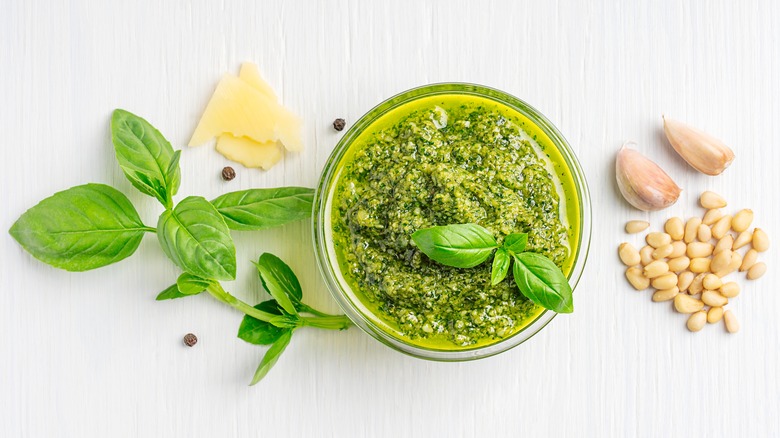The Fishy Ingredient That May Be Hiding In Walmart's Pesto
What's in your pesto? If you are like TikToker @padiano you may be surprised that your favorite store-bought pesto "may contain traces of anchovy, sardines, tuna, muscles." While holding up a jar of Walmart's pesto, he asked, "Why is this in here?"
The TikTok community had theories. One commented, "They supposed to enhance flavors," while another more specifically said, "umami." Others suspected more practical reasons, "It's made in a factory that also produces those things listed."
It isn't just Walmart. Trader Joe's Genova Pesto labels also indicated something similar, according to the Food is Good app. Although sometimes cooks include fish sauce in pesto to boost the umami flavor, that isn't the most likely answer. More likely, the pesto packaged by Walmart, Trader Joe's, and others were manufactured in a facility that also makes Caesar salad dressing or another product that intentionally contains fish.
The use of the words "may contain" are a voluntary warning for people with food allergies that there is a possibility of cross-contact with ingredients they need to avoid. Around 4% of adults and 4% – 6% of children have been diagnosed with food allergies [per CDC]. According to the FDA, people with food allergies may experience symptoms within minutes to hours of consuming those ingredients. These symptoms may include anything ranging from upset stomach, hives, difficulty breathing, and even loss of consciousness.
Food labels are essential reading if you have food allergies
The FDA also identified common sources of food allergies including milk, eggs, fish, Crustacean shellfish, tree nuts, peanuts, wheat, soybeans, and sesame. The FDA requires that these ingredients be clearly listed on the label, but they haven't specified the minimum threshold. Some manufacturers voluntarily take it a step further by using advisory statements like "May contain" or "produced in a facility that also uses."
These statements alert people with allergies or other strict dietary concerns that since the food was made in a shared facility there may be some cross-contact, according to the FDA. Food brands often make multiple food products using the same production line or equipment. While many people won't mind or notice traces of muscles in their pesto, it's dangerous to someone with a shellfish allergy. Even after cleaning the equipment, there may be tiny amounts of an allergen like seafood or nuts that make it into the product.
If you prefer to know exactly what is in your pesto, your best bet is to make it yourself. Luckily, it is easy to make since the magic is mostly in the ingredients. Feel free to try our simple pesto recipe.

